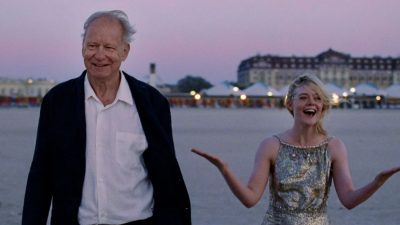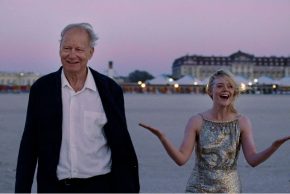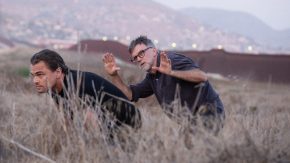French-German art director Oliver Juan has been studying and reflecting about human beings’ ecological behaviour for many years now. He has worked within UNESCO, wrote several publications on the topic, and organised and facilitated workshops at the Sustainable Development Goals conference in Berlin in 2020. He constantly seeks ways to deliver important but out-of-comfort-zone messages to people, and this is what I-Opener: A call for empathy in times of ecological crisis was born from. It will have its world premiere free of charge in Budapest, Hungary, and these are the exclusive details that Oliver Juan revealed to us.

Can you tell me what I-Opener is about?
It is an art exhibition that is strongly pushed by the important scientific findings of the recent era. My studies on psychology and sustainability inspired me to create something that went beyond academia. I have been working on it for more than two years, and after the long break of the pandemic, this will be its world premiere in the Turbina Cultural Center, Budapest (Hungary). The exhibition consists of an immersive and interactive video installation that will engage the audience in a dialogue in multiple ways.
Why immersive and why interactive?
I-Opener deals with hard topics and I want nothing less than to make participants reflect on their own behaviour. Hence the wordplay in the title: to open participants’ eyes and make them self-reflective. It is interactive because I want to push for a collective endeavour across the visitors who would rethink our situation about the next generations to come. Intergenerational judgement is a phenomenon often present today, and I-Opener deals with it in a rather provocative way. In my artistic approach, people will share the space with strangers, just like we share the planet with each other. Several sessions of the same video installation will be played, and interaction between the people on the basis of the videos is encouraged within the setting. Everyone can only visit the exhibition once (that’s why it is a good idea to register here), which symbolises the fact that everyone can belong to only one generation. In Turbina there will be 13 such sessions per day on four days during the last weekend of December. And the exhibition is immersive because, due to the targeted stimulation, people will indeed want to react to what they see.
What kind of provocative examples are raised through the videos?
I’ll tell you one example, which is of the jellyfish. Humans do not really have any empathy or sympathy for the jellyfish. But if we had that, we should be very happy about the success of the jellyfish: they benefit from climate change a lot, they live their best life! Why don’t we rejoice? This weird-sounding example wants to show that humans have to redirect empathy from animals to the next generations. We shouldn’t worry about “killing the planet” but killing ourselves, one animal among many. The planet, the natural kingdom will regenerate, but we take the responsibility for the next generations to prosper. It’s not nature we harm, it’s ourselves.
I’ve heard your show is partly supported by Greenpeace. Doesn’t your message go against theirs?
I respect organisations like Greenpeace and WWF, but I see some of their strategies critically. There is this capitalised empathy, like the pandas in the WWF logo. We feel empathy for the cute little pandas and don’t want their habitat to be destroyed. But has that strategy worked for the past 50 years? Not really. Or at least not fast enough.
Do you mean that we shouldn’t feel empathy for animals?
Of course we need empathy for animals, and we should care about the natural kingdom. However, the jellyfish is a good example that we do not feel the same for all kinds of animals. It is a cause of natural selection that we mostly care about our children who hold our genes. So cute animals that resemble babies have a better chance in evoking our sympathy and empathy. The jellyfish is too different, not human-like at all, so we cannot really feel happy about him prospering: we don’t like him. To work with the best examples, I even contacted a think tank in Berlin about this topic, and on the spot of the exhibition I am going to sell postcards with those animals that temporarily “benefit” climate change. People should reflect on the message of redirecting empathy from “Nature” to the future generations of humanity. Greta Thunberg giving an emotional speech at the UN Climate Action Summit 2019 about this issue is an important symbol.
Largely this is the content of my exhibition. But how can you make participants really feel it, as strongly and emotionally as Thunberg has done, instead of just getting it as some written information in a newspaper or an academic journal? Academia and rigorous knowledge is useful but not enough. There is a growing discrepancy between academia and the everyday world, and arts are a great tool to bridge them.
Are you close to the world of arts-based research yourself?
I really like research, at the moment I’m doing my second Master’s degree. People usually don’t do that, they go for a PhD if they want to pursue more research. But a PhD project would cost too much of my energy and psychic stability, so I postpone it at least for now, and therefore have more time to spend with arts. I can freely reflect on questions like: can arts change the world? Can research use the aesthetics of arts? I’m still 25, so I’ll have time to do a PhD later if I want to.
How were the videos created?
I am the art director of I-opener. I presented the initial version at a sustainability themed festival in Berlin 2,5 years ago, before the covid-19 pandemic. I saw then that there were many gaps and lots of potential, so I looked for people to join and fill them. I found a sound designer and different kinds of visual artists, so now there are 7 of us in total. Everyone works on this exhibition in their free time. We use a lot of materials: animation, our own pictures, some stock pictures, video footages, music, photo collages. We have two big collages of many different little photographs that create a coherent image, which is an allegory of our fragmented society that should find cohesion in the present moment. I wrote the script for the exhibition, asked a friend to record it, and I’m also the VJ of the exhibition. There are three rooms in total, all making sense once you understand their function. But there is some surprise there, too, which I cannot reveal beforehand.
Wow, it really sounds like many types of artworks!
Yes, the biggest challenge was to create a coherent style, but I guess it worked out well. Buzzwords like “empathy”, “immersive” or “sustainability” helped in this regard. There is a professional curator working on I-Opener, too, and we all do a good joint job. As the exhibition deals with a very important societal issue, I really would like to encourage everyone, regardless of age, gender, profession, family status, etc., to come and be part of this unique experience. It is a question of everyone’s future, so everyone should feel concerned about taking part in finding the right answers.
































Comments
1 Responses to “Oliver Juan: if we empathise with the panda, why not with the jellyfish?”